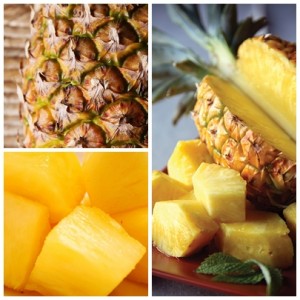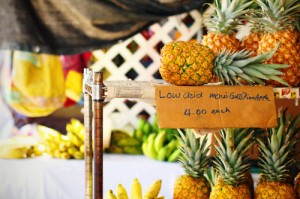Pineapple Juice
The Pineapple
The pineapple is a tropical, drought-tolerant plant that bears long oval or cylindrical fruits which are both juicy and deliciously fleshy at the same time. Its tough and waxy outer covering ranges from dark green, yellow, yellow-orange to reddish, depending on its ripeness. Its flesh color ranges from pale to dark yellow.
or cylindrical fruits which are both juicy and deliciously fleshy at the same time. Its tough and waxy outer covering ranges from dark green, yellow, yellow-orange to reddish, depending on its ripeness. Its flesh color ranges from pale to dark yellow.
This famous fruit was named pineapple by European explorers because it looked like a pinecone on the outside and its flesh looked like an apple on the inside.
Its unique sweet-sour taste made it popular for salads, desserts, ice creams, candies and jams. Unlike most fruits which develop in 3-4 months, this berry takes about 18-24 months to grow to its full size. The pineapple is mainly produced in Southeast Asia (Philippines and Thailand), Hawaii and Brazil.
Various Uses of the Pineapple
 The pineapple is used and consumed in a variety of ways—fresh, canned, juiced. Its waste parts left from the canning process (the skin, core and ends) are used to make alcohol and vinegar, and even food for livestock. Its leaves are used as a source of textile fiber called the piña, which can be used as material for bags, linens, and other clothing items like the Philippine male formal wear Barong Tagalog.
The pineapple is used and consumed in a variety of ways—fresh, canned, juiced. Its waste parts left from the canning process (the skin, core and ends) are used to make alcohol and vinegar, and even food for livestock. Its leaves are used as a source of textile fiber called the piña, which can be used as material for bags, linens, and other clothing items like the Philippine male formal wear Barong Tagalog.
Its flesh is also used for culinary purposes as a meat tenderizer because it extracts bromelain, a proteolytic enzyme that is thought to reduce inflammation after surgery. Canned pineapple, however, cannot be used for such purposes because bromelain is destroyed throughout the canning process (because of the heat).
Interesting Facts about the Pineapple
 1. The same man who discovered the Americas introduced pineapples to Europe. Yes, it is no other than Christopher Columbus!
1. The same man who discovered the Americas introduced pineapples to Europe. Yes, it is no other than Christopher Columbus!
2. The pineapple is actually a multiple or compound fruit because it consists of many small berries fused together.
Pineapple Nutritional Value
(per 100g)
Dietary fiber: 1.4 g
Sugar: 9.5 g
Vitamin E: 0.62 mg
Vitamin B6: 0.111 mg
Vitamin B5: 0.205 mg
Vitamin B3: 0.495 mg
Vitamin B2: 0.031 mg
Vitamin B1: 0.079 mg
Vitamin C: 37.2 mg
Fat: 0.12 g
Protein: 0.54 g
Carbohydrates: 13.2 g
Zinc: 0.11 mg
Phosphorus: 10 mg
Iron: 0.29 mg
Potassium: 110 mg
Calcium: 13 mg
Calories: 48 kcals per 100g/3.5oz
Pineapple Health Benefits
Prevents scurvy
During the early European exploration, sailors escaped scurvy by eating fresh pineapples which are a rich source of Vitamin C.
Easiest treatment for worm infestation
The bromelain content together with fruit’s high fiber content will help you get rid of tapeworms. Just drink pineapple juice on an empty stomach or fast on raw pineapples for 3 days for anti-parasitic effects. Bromelain in pineapples also help kill the larvae before they even hatch.
A natural remedy for arthritis
To relieve pain and stiffness of arthritis, prefer to eat fresh pineapples instead of canned or frozen ones. The bromelain in pineapples is responsible for this amazing remedy, due to its natural anti-inflammatory and analgesic properties. This enzyme is clinically proven to ease joint pain and discomfort. Since most of the enzyme is concentrated in the core of the fruit, you can add the stem to your pineapple smoothies to make the most of its pain-relieving effects.
Soothes sore throats
Pineapples do not cure the sore throat, but alleviates the pain that goes with it. The bromelain extract reduces the irritation, and the Vitamin C helps boosts your immune system and helps you recover faster.
 Rich in antioxidants
Rich in antioxidants
Flavonoids, Vitamin A and C are the antioxidants present in pineapples. These reduce the oxidative damage caused by free radicals. One cup of pineapple juice contains more Vitamin C compared to one cup of apple, cranberry or tomato juice.
Strengthens bones
Pineapples supply a good amount of iron, and thus strengthen your bones. You can also blame it to the very high manganese content of the fruit. Manganese prevents osteoporosis and bone fractures. This mineral helps build connective tissues like bone, skin and cartilage. One cup of pineapple provides almost 75% of the recommended amount of manganese daily. Bone fractures can heal faster by eating pineapples every day until the fracture is completely healed.
Other health benefits
Pineapple prevents or helps cure bronchitis, high blood pressure, nausea and constipation.
Pineapple Juice Recipe
This is a simple straightforward recipe for making fresh homemade pineapple juice. Make sure that you get ripe pineapples, they will have more juice in them. Pineapples are a great fruit for juicing since they contain lots and lots of fluids.
Ingredients
One pineapple will make you enough juice for two people. This is all you need. Alternatively – if you want to make a smoothie bananas go great with pineapples. So I will also include this version of the recipe into instructions.
Instructions:
- Clean the pineapple and cut out the flesh.
- There are two ways of making pineapple juice. You can make it thick and pulpy or a bit more liquid and clear. If you want thick use a blender otherwise a juicer. The best juice is made by using half of pineapple in a juicer and the other half in a blender an then combining both juices. This will give you just the right thickness.
- This is it, you are done.
- As said, a great way to improve your pineapple juice is to add a banana. So peal the banana and add it to the blender when making juice. Banana goes great with almost every fruit but with pineapple it seems like the are about to be married – tastes great! :)
More Pineapple And Pineapple Juice Articles
Best Pineapples For Pineapple Juice And How To Choose Them
Pineapple is a tropical fruit with an exotic appearance and …Pineapple Juice Side Effects: Can You Drink Too Much Pineapple Juice?
Pineapple juice side effects are rare and usually occur when …Pineapple Nutrition Facts
Pineapple Nutrition Facts Betaine 0,1 mg Calcium 13 mg Calories …Pineapple Piña Colada Recipe
We usually don’t post juice recipes that have alcohol in …Need To Know Facts About The Health Benefits Of Pineapple Juice
The health benefits of pineapple juice are undeniable. It contains …

